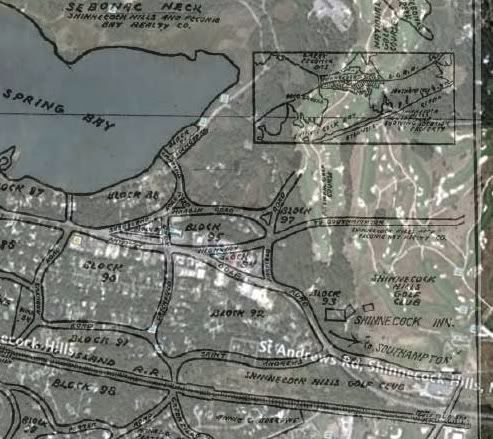1. In his long post a few above, Mike insists that the SHPB development was not adjacent to NGLA. Here again in this last post Mike contrasts the NGLA site with the previous CBM 120 acre site, as if the NGLA site was somehow remote to the rest of the development. This just isn't true or accurate. NGLA was right next to the SHPB development and
NGLA's de facto clubhouse was a key component of the development!
Here is an overlay of a section of that Development which shows that NGLA was adjacent to the development, as was NGLA's de facto clubhouse, the Shinnecock Inn.

Also, SHPB most certainly viewed NGLA as adjacent to the development, or even part of the development itself!.The advertisements for the SHPB development repeatedly highlighted the proximity and easy access to NGLA from every building lot on the entire development. Indeed, the advertisements treat NGLA as if it were part of the same development, and it some sense this was true, given the prior ownership, the contiguousness of the land, the cooperation (according to Goddard) between CBM and SHPB in locating the Inn/Clubhouse, and the dual role the Inn was playing as on-site headquarters of the development and as NGLA's de facto clubhouse. Here (From Goddard's book) is what the President of SHPB had to say in his annual report to investors at the end of 1906:
In his first report to the stockholders at the end of 1906, he gloated that Macdonald and his co-religionists “intend to make this golf course famous both here and abroad, desiring that it shall be so well known that visiting foreigners and golfers from all over America shall make it a center for this sport. The advantage to your property of having located there two of the oldest and certainly the best of golf courses is obvious.” -- Goddard, David (2011-10-24). Colonizing Southampton (Excelsior Editions) (p. 247). State University of New York Press.
The reason it was so obviously advantageous was because it was right there, adjacent to the development, and because it would draw potential customers for both the Inn and the building lots.
2. In both the long post and in this most recent one, Mike claims that SHPB "considered [the NGLA property] worthless." He is of course taking CBM's description of the pre-purchase property out of context.
In fact, the SHPB considered the land quite valuable, especially once CBM determined to build what SHPB hyped as the finest golf course in the world on the property. The golf course enhanced the value of the entire development, including the rest of Sebonac Neck, and SHPB was well aware of this even before the sale was final. Look at CBM's Jan. 1, 1912 letter, where CBM noted that SHPB was reluctant to sell CBM land currently occupied by the pro shop for less than $1000 per acre, and that SHPB had received bids for the land adjacent to the current pro shop of over $1000 per acre. Or again, see their advertisements, and the quote by their President from late 1906 where he stated, "The advantage to your property of having located there two of the oldest and certainly the best of golf courses is obvious.”
Thanks to the NGLA deal, the value to the SHPB development was "obvious." To everyone but Mike.